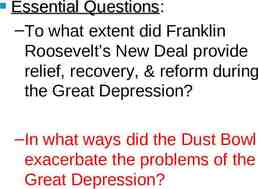Calculate decimal equivalents of fractions Revise Every proper
16 Slides257.34 KB
Calculate decimal equivalents of fractions Revise Every proper fraction has a decimal number equivalent which we can calculate by dividing the numerator by the denominator. Common decimal equivalents of fractions can be learnt as facts: Fraction 0.5 Decimal 0.25 0.1 0.2 We can calculate the decimal equivalents of trickier fractions using written methods of division: 0 5 5 5 9 5 5 0 5 0 5 0 Sometimes a decimal equivalent will keep going infinitely. This is called a recurring decimal. In these cases, you can round the decimal or use a dot to show the same digit is repeated. 0.56 rounded to two decimal 0. places
Quiz Calculate decimal equivalents of fractions What is the decimal equivalent of this fraction? 3 8 0.125 0.25 Correct! Try again! 0.375
Quiz Calculate decimal equivalents of fractions What is the decimal equivalent of this fraction rounded to two decimal places? 2 7 0.27 0.29 Correct! Try again! 0.28
Identify the value of each digit in numbers to three decimal places Revise In order to be able to read, write and calculate with decimal numbers, we need to understand the place value of each digit after the decimal point. As the place value position moves right of the decimal point, the digits become ten times smaller. ones tenths hundredths thousandths
Identify the value of each digit in numbers to three decimal places Quiz What is the value of the underlined digit? 13.508 5 100 5 10 Correct! Try again! 5 1000
Identify the value of each digit in numbers to three decimal places Quiz What is the value of the underlined digit? 529.078 8 1000 8 10 Correct! Try again! 8 100
Order and compare numbers with up to three decimal places Revise To order decimal numbers, we compare the place value of the digits in each number, starting with the digits in the largest place value position. If numbers have the same digit in a place value position, we look at the digits in the place value position to the right until we find a difference. When comparing numbers, we can use symbols to show which is the smaller or larger number. 0.873 0.853 0.205 0.215 is less than is greater than
Order and compare numbers with up to three decimal places Quiz Choose the correct symbol to compare these decimal numbers. 0.436 0.416 Correct! Try again!
Order and compare numbers with up to three decimal places Quiz Choose the correct symbol to compare these decimal numbers. 0.013 0.103 Correct! Try again!
Order and compare numbers with up to three decimal places Quiz Choose the correct symbol to compare these decimal numbers. 1024.663 1024.673 Correct! Try again!
Revise Multiply one-digit numbers with up to two decimal places by whole numbers Short Multiplication We use short multiplication when we are multiplying a decimal number by a one-digit number. Position the decimal number above the one-digit number. Make sure that the place value columns are correct. Starting at the right-hand side, multiply each digit in the decimal number by the one-digit number. We can only write a single digit in each column, so if the product is a two-digit number, we have to regroup the number and place into the next column. We do this by writing the number above the digits in the next place holder. 4 3 5 3 6 4 5 9 8 2 4 When we regroup, we must remember to add this number to the multiplication answer of the next digit. Make sure you give your answer as a decimal.
Revise Multiply one-digit numbers with up to two decimal places by whole numbers Long Multiplication We can use long multiplication when we are multiplying a decimal number by a two-digit number or larger. Position the decimal number above the two-digit number. Make sure that the place value columns are correct. Starting at the right-hand side, multiply each digit in the decimal number by the ones digit, regrouping and placing into the next column if necessary. Strike the regrouped numbers once you have your first answer so that you don’t confuse any in new Place a zero theregroupings. furthest right-hand column on the next row down to show we are now going to multiply by a power of ten. 2 2 4 1 4 2 8 3 4 2 1 2 6 7 6 3 8 2 6 4 0 8 0 8 1 1 Starting at the right-hand side multiply each digit in the decimal number by the tens digit, regrouping and placing into the next column if necessary. Finally, add the digits in each column using column addition to find the answer.
Multiply one-digit numbers with up to two decimal places by whole numbers Quiz What is the answer to this decimal multiplication? 5.47 2 10.814 10.94 Correct! Try again! 10.82
Multiply one-digit numbers with up to two decimal places by whole numbers Quiz What is the answer to this decimal multiplication? 7.08 15 106.2 135.04 Correct! Try again! 105.102
Revise Use written division methods in cases where the answer has up to two decimal places Short Division We can use short division when we are dividing a decimal number by a one-digit number. 1 3 2 5 Start by dividing the first digit of the 4 5 13 10 dividend (the number that is being divided: 53) by the divisor (the number which is being divided into: 4). Write the answer above the horizontal line and regroup any remainder to the next digit. 0 2 Remember to keep the decimal place in the same place value position.
Revise Use written division methods in cases where the answer has up to two decimal places Long Division We can use long division when we are dividing a decimal number by a two-digit number or larger. Start by dividing the first two digits of the dividend by the divisor. Write the answer above the dividend and the multiple of the divisor below. Use column subtraction to calculate the remainder and draw down the next digit of the dividend. Repeat this process until the end of the calculation. Remember to keep the decimal place in the same place value position. Sometimes the answer to a decimal division may continue into many decimal places.





















